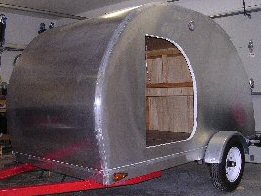Still confused regarding frame grounding for AC and DC.
59 posts
• Page 3 of 4 • 1, 2, 3, 4
Don't forget a fuse or circut breaker upstream of your main cutoff.
Bruce
Bruce
2009 6.5'X11' TTT - Boxcar
All it takes is a speck of faith and a few kilowatts of sweat and grace.

Boxcar Build
aVANger Build
All it takes is a speck of faith and a few kilowatts of sweat and grace.

Boxcar Build
aVANger Build
-

bdosborn - Donating Member
- Posts: 5493
- Images: 772
- Joined: Wed May 05, 2004 11:10 pm
- Location: CO, Littleton
Powderburn, you said <B>"If the main braker is GFCI,your whole system is GFCI protected. If your camp site offers a 30ampre GFCI protected plug,you are protected without any GFCI's in your trailer."</B>
The box that I looked at HD didn't have a main breaker in it, just slots for two 1" or four 1/2" breakers. I asked a salesperson about GFCI devices other than receptacles and they said they had none. I wanted to put a GFCI before the breakers and didn't know there were main breakers with GFCI at the time. I guess I'd better look again and find someone who knows more about what they sell. Or go to an electrical supply dealer. I would hope that campgrounds have GFCI protected plugs, but there's no guarantee of that, so I want them in my trailer's electrical system.
Thanks for the reply. I'll be back online on Monday to check here.
The box that I looked at HD didn't have a main breaker in it, just slots for two 1" or four 1/2" breakers. I asked a salesperson about GFCI devices other than receptacles and they said they had none. I wanted to put a GFCI before the breakers and didn't know there were main breakers with GFCI at the time. I guess I'd better look again and find someone who knows more about what they sell. Or go to an electrical supply dealer. I would hope that campgrounds have GFCI protected plugs, but there's no guarantee of that, so I want them in my trailer's electrical system.
Thanks for the reply. I'll be back online on Monday to check here.
Dale
Sometimes I pretend to be normal. But, that gets boring...so I go back to being me.
Squidget Pop Top Build Pages http://www.thesquidget.com/ptbuild/ptbuild.html
Squidget and Pop Top Plans Info and Photos: http://www.TheSquidget.com
Sometimes I pretend to be normal. But, that gets boring...so I go back to being me.
Squidget Pop Top Build Pages http://www.thesquidget.com/ptbuild/ptbuild.html
Squidget and Pop Top Plans Info and Photos: http://www.TheSquidget.com
-

cracker39 - 3000 Club

- Posts: 3069
- Images: 233
- Joined: Thu Jun 30, 2005 2:18 pm
- Location: Lake Alfred, Florida, USA



 , Aircraft that use both AC and DC use the airframe as a common earth or ground circuit with no deleteriouos or unusual effects as long as the grounding points are kept clean. I once fitted a 12V alternator to a cousins furniture removal truck (a Hino with a standard 24V system) and there were no ill effects or funny business. It is still running his 12V power tailgate and its battery system and the 12V alternator was fitted about 15 years ago or so. Because of the mileage the truck does I've had to overhaul the alternator a couple of times in that time but it's still doing the job. The old Canberra bombers (B-57s to our Amercian friends) had a number of different voltages and frequency systems that used the airframe as the earth and there were never any issues other than dirty/corroded earth points.
, Aircraft that use both AC and DC use the airframe as a common earth or ground circuit with no deleteriouos or unusual effects as long as the grounding points are kept clean. I once fitted a 12V alternator to a cousins furniture removal truck (a Hino with a standard 24V system) and there were no ill effects or funny business. It is still running his 12V power tailgate and its battery system and the 12V alternator was fitted about 15 years ago or so. Because of the mileage the truck does I've had to overhaul the alternator a couple of times in that time but it's still doing the job. The old Canberra bombers (B-57s to our Amercian friends) had a number of different voltages and frequency systems that used the airframe as the earth and there were never any issues other than dirty/corroded earth points.
 ,
,

